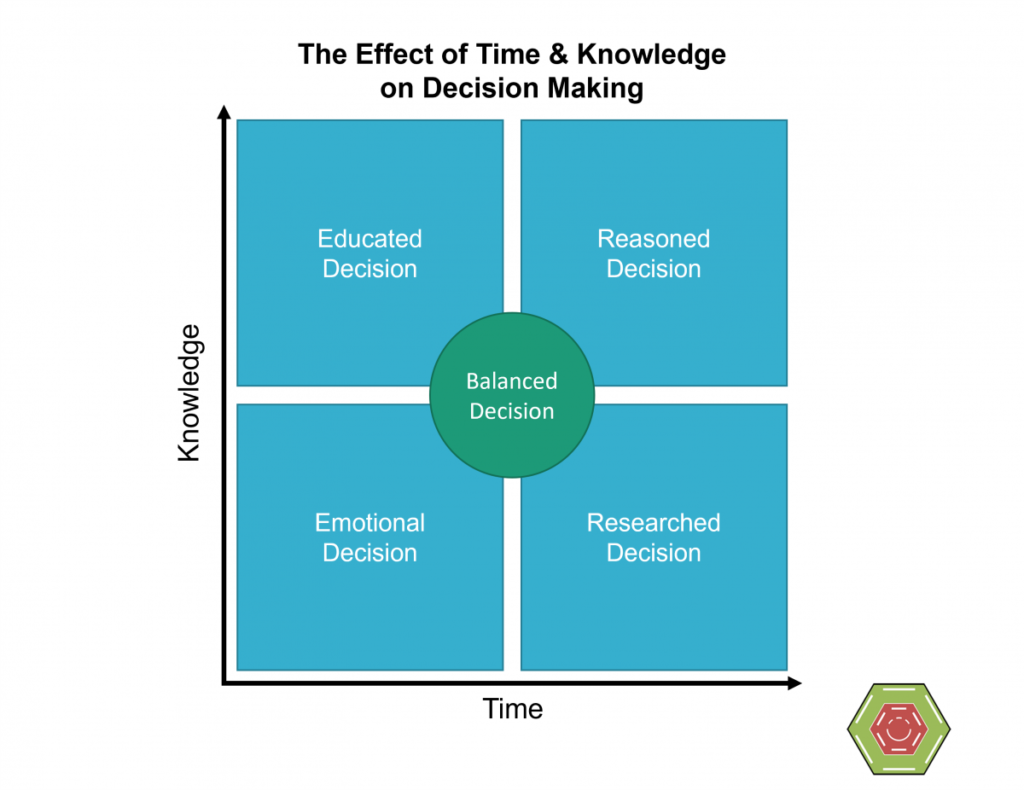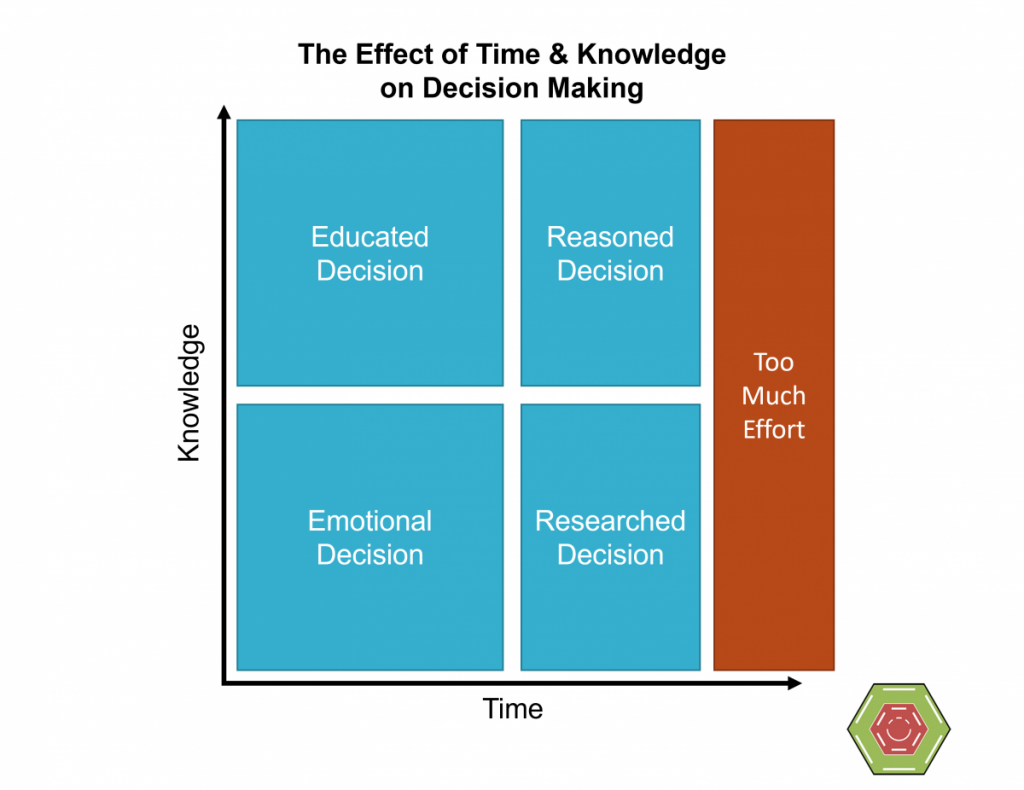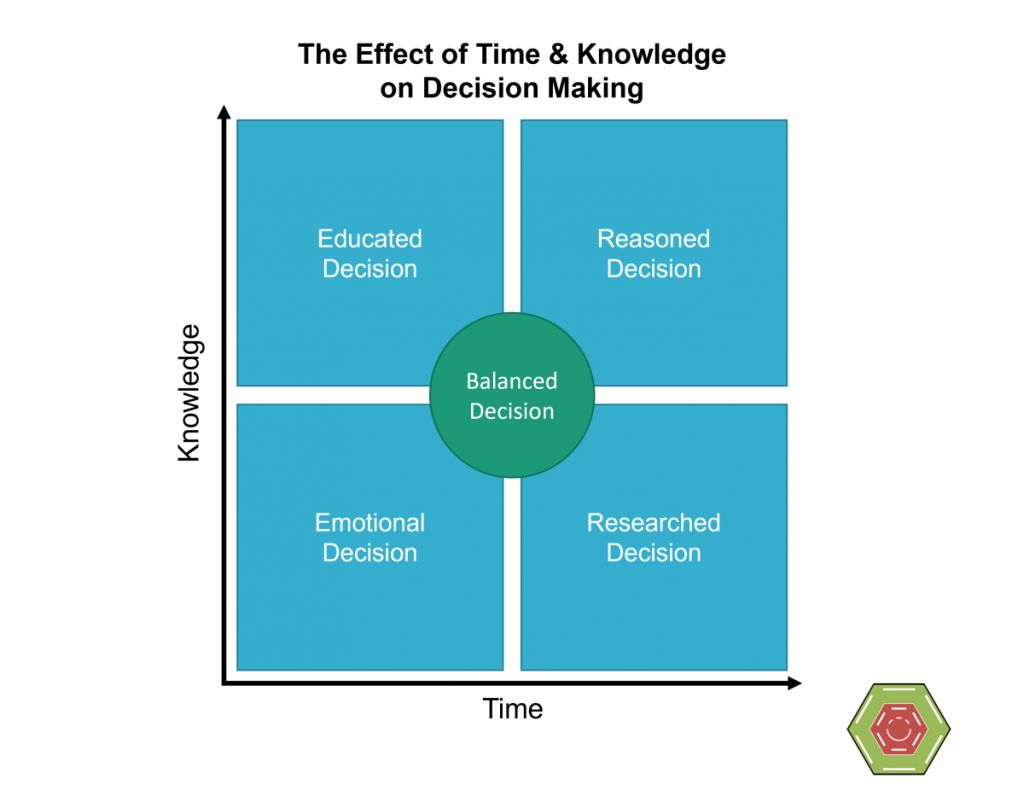The Effect of Time and Knowledge on Decision Making

Many moons ago, I wrote an article titled “The Effect of Time on Decision Making”. In it, I covered some fairly meaty topics that talked about Construal Level Theory and Decision Field Theory and how they explained the way we made decisions.
The Basic Theory
Very simply out, Construal Level Theory tried to explain how we prioritise a decision based on how close it is to us. If it is abstract, or a decent time in the future, then we give it less merit and less focus. If it is concrete, or very close in time to now, then we will do the opposite – give it stronger focus and concentrate more on making a decision.
Decision Field Theory talks more about the actual process of making the decision. Multiple outcomes and threads will be in our minds and as we add more information and have more time, we make potentially better or at least more informed decisions, by filtering out those that no longer fit our current level of understanding.
When we combine these, we start to get an interesting look at how time can affect our decision-making process. Whilst it may seem that having more time would lead to better decisions, if we look purely at Decision Field Theory, Construal Level Theory tells us that too much time will lead to postponing that decision in favour of other, more concrete decisions that need to be made.
However, if we don’t have as much time to make the decision, we potentially throw out the best ones in favour of the ones we can reach quickest.
What a paradox. We are saying that more time does not always lead to better decisions, but then neither does less time! How very Goldilocks of our brains!
The Effect of Knowledge and Time in Decision Making
So, let’s look at it slightly differently to just the effect of time on decision making, and pull something practical out of it all!
I propose the following concept – which I will build up on – so don’t just steal this image!
Decision Making Time and Knowledge 1
If we are short on time and have little knowledge of the question at hand, we are going to make emotional decisions. These are decisions where we just don’t have enough concrete understanding to apply, so we have to just go with what feels right.
The more knowledge you have on a topic, the less you need to rely on emotion and the more you can rely on the implicit understanding, making an educated decision in a short time.
Take a quiz for example. You are asked, “Which member of The Beatles wrote Yellow Submarine?”
If you don’t know the answer and know nothing about the Beatles, you are going to take a pure guess on gut instinct and maybe say Paul McCarney as he is still pretty famous and you know he was a Beatle.
If you know a little bit about the Beatles, you might know that John Lennon had the most writing credits – so he is a safe bet. Here you are in between an emotional answer and an educated one.
If you are a Beatles fan, you may well immediately know that it was in fact Ringo Starr – providing an educated instant answer.
If we now extend the time, so no longer a quiz, but a question in a newspaper crossword. Whilst there still is a slight time constraint in that you would want to finish the crossword today, you are able to take longer.
If you just don’t have the knowledge and you can’t get to the answer, you might decide to hit the internet and research it. This takes effort, so may put you off, but if you are reaching the end of the day and your internal deadline is becoming more concrete – this may be your only way to get the answer.
However, if you are a fan of the Beatles, you may be able to reason your way to the answer, even if it is not on the tip of your tongue. It might be that you initially go with Lennon, but do not feel it is right (or in the case of a crossword, it isn’t the right number of letters). So you think some more about it and slowly start to remember a documentary you saw about Beatles songs and then, all of a sudden, the info is there – it was Ringo Starr! It is still taking effort, but the extra time allows your brain to do its thing and filter through the information stored there and keep adding knowledge and filtering out the wrong answers.
Remember that more time doesn’t always mean people will use that time correctly. Having 2 hours to make a decision, does not mean I will spend 2 hours making the decision! Also, if making that decision feels like it is too much effort, having more time won’t make any difference either. You could almost add a new dimension to the chart that has effort pushing back on the likelihood that you will correctly use the time to make a decision.
 Decision Making Time and Knowledge 2
Decision Making Time and Knowledge 2
Designing for Balance
With all this said, the reality is most people will be making balanced decisions throughout their day. Where their knowledge is reasonable and the time given is reasonable and the amount of effort required is…. reasonable. A happy and comfortable medium, that leads to us making decent decisions that we are happy with throughout the day.
When we build our gamified solutions, we can make use of this to make users feel like they are winning and doing the right things for the majority of their time.
By providing enough information and giving them enough time to make balanced decisions, they will more often than not be making good decisions and feeling happy with what they have done.
 Decision Making Time and Knowledge 3
Decision Making Time and Knowledge 3
Creating Challenges
Then, to keep things interesting, we can play around with the balance to create challenges.
First, we can reduce the amount of knowledge provided to them, but provide a little more time for them. This forces them to either research or reason their way to a decision – pushing them slightly out of their comfort zone. In a game, this would be some sort of strategic siege of a new type of base. You have a general level of knowledge regarding sieges, but you don’t know the specifics of this base. So drawing on your existing knowledge, you take time to test defences, scout for weak spots and research the enemy’s strengths and weaknesses.
Alternatively, we can reduce the time limit, forcing you to make instinctive decisions. If you are playing a shoot’em up game, this could look like faster enemies and more of them entering the screen. If you are skilled, then your decisions on where and when to shoot will be educated and probably better aimed. However, increasing the speed further would lead you to guess more, using emotional instinct to hit your targets.
In both instances, we are pushing the player to make decisions in different ways.
Limited Time Offers
I thought I would finish on a retail trick – the limited-time offer. We’ve all experienced it. You are looking to buy something and you are presented with a limited-time offer. Buy in the next 15 minutes and you will get a sweet deal. It could be online, it could be a salesman telling you that “If you pay in cash now, I’ll give you 15% off – but my boss won’t let me carry this over until tomorrow”.
Retailers do this to try and encourage you to make an emotional decision. To make the desire to own the item outweigh the need to own it. Here they are taking away the time needed to reason or research your decision. This is very powerful and even more so when we combine it with FOMO messaging – only 3 left and Dave just bought one!
However, this needs to be used sensibly as people do become immune to it, especially if they feel the only reason to do it is to trick them. However, when done properly and used as a way to inform the buyer that there is a limit to how long they can wait to make their decision, then it can be powerful and helpful. It is more annoying to miss out on an item because you didn’t know there was limited stock than it is to be informed there is limited stock!
So there you have it. Hopefully, this is handy, if only for the image. Time makes a massive difference to how we make decisions as does the information we have available to us. Use both to challenge and encourage users.
The post The Effect of Time and Knowledge on Decision Making appeared first on Gamified UK – #Gamification Expert.







